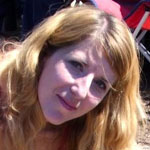Librarian digs her dream at SMU-in-Taos
Librarian Kena Sosa entered a radio contest to be "Indiana Jones" for a day and won a chance to dig at SMU-in-Taos.

By Kim Cobb
SMU News
DALLAS (SMU) – Kena Sosa’s dream involved history, the search for ancient cultures and a lot of dirt. Thanks to a Dallas radio station and an enthusiastic SMU professor, Sosa was able to live out her “Indiana Jones” fantasy this summer at the Archeology Field School at SMU-in-Taos.
In the days leading up to the annual Martin Luther King Jr. holiday in January, syndicated Dallas radio personality Kidd Kraddick was encouraging listeners to enter his “I Have a Dream” contest with a creative, 100-word essay. Sosa, a Dallas Independent School District librarian and part-time freelance writer, thought it was a challenge she could meet.
“I wrote about wanting to be Indiana Jones for a day and uncover something no one had seen for hundreds of years,” Sosa said. “My husband and I have been to many sites of ruins in Mexico and find them so fascinating. But climbing pyramids is not the same as unraveling the mystery of how the people there lived or why they did what they did.”
The radio station let Sosa know she was a finalist, so she was carrying her cell phone in her pocket just in case. Sure enough – the phone rang when she had a room full of 5th graders. The call was from Kraddick, who introduced her “on air” to SMU-in-Taos Executive Director and archaeologist Mike Adler, who had arranged to make her dream a reality at a real archaeological dig at SMU-in-Taos. The prize package included an airline ticket and funds to cover her hotel and related expenses.
Her day in the Taos dirt was June 23, and it more than lived up to Sosa’s expectations.
“I hoped the dig would prove to be full of discovery, which it was,” she said. “I didn't realize just how much physical labor everyone is expected to do. It really is a dirty job, but one full of new bits of information and theories. And it was a lot of work.”
She worked alongside a student team digging to new levels, Sosa explained, trying to uncover artifacts and the walls or floor to a pit house – an ancient type of dwelling that was partially excavated into the earth and then roofed with wooden poles and mud.
“We were covered in dirt, hot, but fulfilled,” Sosa said. “I was really surprised at how much documentation and paperwork is involved, mostly to avoid the sloppy excavation mistakes seen decades ago, but still it was very meticulous. Luckily I didn't have to do that.”
The view from the mountain where they were working was breathtaking, and Sosa enjoyed the camaraderie with the students, who were eager to share with her what they had learned. “Although doing serious work, they kept it fun, laughing at each other's dirt mustaches,” Sosa said.
Sosa says she is determined to return to Taos one day. She’s very busy raising two young sons, now, but concedes that a change in career path from librarian to “Indiana Jones” could be a “real possibility” once the boys are older.
SMU is now in its fourth decade of offering field archaeology at the Taos campus, and Adler estimates more than 1,000 undergraduate and graduate students have trained there. The field school is home to the Taos Collaborative Archaeology Program (TCAP), a unique education and research partnership between two of the nation’s leading archaeology programs – SMU and Mercyhurst College in Erie, Pa. Anthropology courses offered at SMU-in Taos explore local Native American cultures and the archaeology of the Southwest, focusing on the continuing excavation and examination of Pot Creek Pueblo and historic Fort Burgwin.
# # #
SMU is a nationally ranked private university in Dallas founded 100 years ago. Today, SMU enrolls nearly 11,000 students who benefit from the academic opportunities and international reach of seven degree-granting schools.
SMU-in-Taos has offered courses and research programs enhanced by the bountiful cultural and natural resources of northern New Mexico for almost 40 years. The scenic campus at Fort Burgwin, on the outskirts of Taos in the Carson National Forest, thrives as a center for academic discovery, experiential learning and scholarly research.
09630-nr-07/24/12-kc